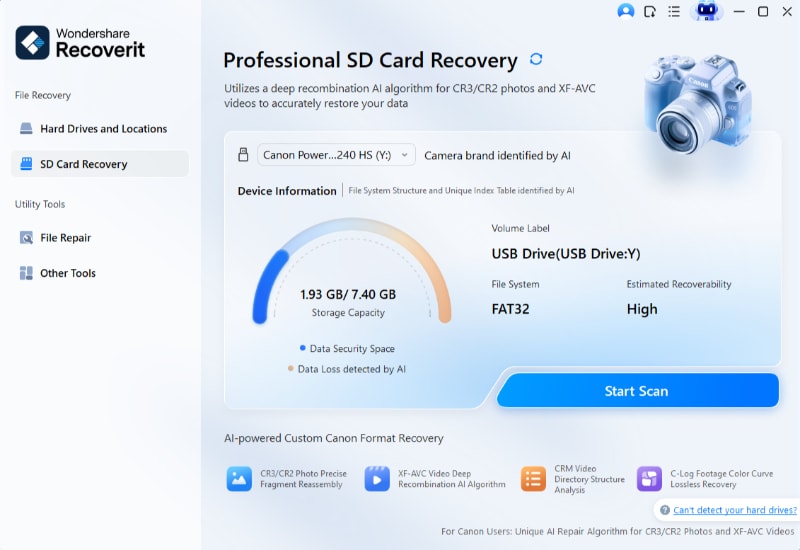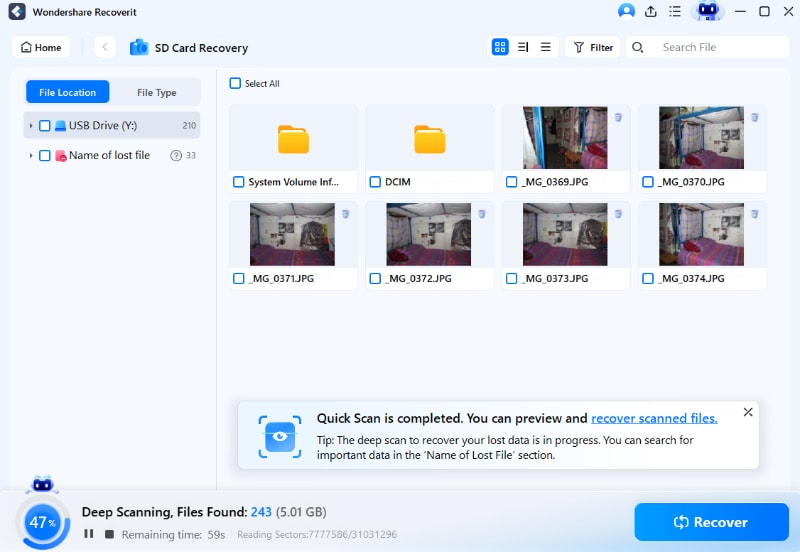How to Format 128GB USB Flash Drive to FAT32 in Windows 7/8/10?
"How to format 128 GB USB Flash Drive to FAT32 file system? I have formatted my 16 GB USB drive to the FAT32 system various times with the help of Diskpart and Disk Management, but this time it's not showing any option for the FAT32 system. Is there any other way to format USB Drive with a larger capacity to FAT32 System?"
Yes, there are other ways to format 128 GB USB Flash Drive to the FAT32 file system on Windows. Although you can't complete the task by using the traditional Diskpart method, there is an integrated way, and there are other ways that take help from third-party apps.
Part 1: Why Do You Need to Format USB Flash Drive to FAT32?
If you are using any USB Flash Drive, Pen Drive, SD Card, etc. then you will need to format it to FAT32 files system for various reasons. The FAT32 file system is preferred by all due to its flexible nature, wide compatibility, and ability to support large data partitions.
There are several reasons due to which you might need to format your USB Drive to FAT32 File System from NTFS, exFAT, or any other file system:
- Most of the gaming consoles like PS3, Xbox, etc. only support the disks or USB Drive formatted to FAT32 File System, in that case, you will need to format your Drive to the FAT32 file system like NTFS or another system will be unsupported.
- FAT32 is widely compatible with various kinds of Operating Systems, unlike other file systems that are selectively compatible. So, if you are going to use your USB Drive with Mac, Linux, or previous versions of Windows, then, in that case, you will need to format your USB Drive to FAT32.
- NTFS and other file systems don't support NAS devices. Thus, if you wish to use your USB Drive with NAS devices, then you'll need to format your USB Drive to the FAT32 file system.
There are many more reasons, but overall, if you wish to use your Drive on a wide range of platforms without facing any troubles, then FAT32 is the best Files System.
You may also like:
Basic Data Partition vs. Primary Partition
Extended Partition vs. Primary Partition
Primary Partition vs. Logical Partition
Part 2: How to Format 128 GB USB Flash Drive to FAT32 in Windows 7/8/10?
In normal cases, there are various ways to format your USB Flash Drive to the FAT32 system. You can use integrated methods; you can use the command line on your Windows, or you can also use a third-party tool to simply format your USB Drive to FAT32. When you try to format 128 GB USB Flash Drive to the FAT32 file system, then things get a little complicated. However, for smaller sized Drives, you can use Disk Management or Diskpart.
Why can't I format 128 GB USB Drive to FAT32 File System using Diskpart or Disk Management?
For most instances where you wish to format a 16 GB USB Drive or a 32 GB USB Drive to FAT32 system, you can do it simply with the help of Disk Management and Diskpart. But when you try to format a 64 GB or 128 GB USB Drive to FAT32 System, you can't do it so with the help of Diskpart or Disk management. While trying to do so, you will face an error through both methods. Why is it so? Because, by default, Diskpart, Disk Management, or other integrated formatting tools of Windows, are configured to format a USB Drive lower than 32 GB to FAT32 system, and USB Drive more than 32 GB to NTFS or exFAT. Thus, when you try to format your 128 GB USB Drive to the FAT32 file system, you will not be able to do so.


Method 1: Format USB drive with Disk Management
For a USB Drive of size 32 GB or lower, you can use Disk Management to format the Drive to FAT32 system. The method is really simple and efficient. All you need to do is to access the Disk Management under Control Panel and follow the steps.
- Connect the USB Drive you want to format to the FAT32 system and make sure it gets detected by your PC.
- Now go to the search panel on Task Bar and search for "Disk Management" and go the Disk Management in the results.
- Once on the Disk Management window, go to the USB Drive you want to format to FAT32 system. Look for your Drive among all the listed once and right-click on it to see the contextual menu.
- From the menu, click on the "Format" button. Now, you will see a Format dialogue box. In the box, choose "FAT32" under the File Systems, and also uncheck the "Quick Format" option. Now, click Ok to start formatting your Drive to the FAT32 system.


You can use this above-mentioned method of Disk Management to format your Drive to FAT32 system, but you can't format larger sized disks with it. However, there's only an integrated way to format your larger USB Drive to the FAT32 system, and that's PowerShell.
Method 2: Format 128 GB USB Drive to FAT32 using PowerShell on Windows
You can format USB Drive larger than 32 GB to FAT32 System using Windows PowerShell. However, the process is less efficient and is prone to take longer during formatting.
Step 1. Once you are on the home screen of your Windows system, use the shortcut "Windows + X" to go to the Start menu.
Step 2. Now, in the menu, look for the "Windows PowerShell (Admin)" option and click on it to open PowerShell as the Admin.

Step 3. Once you are on the PowerShell window, type the command "format /FS: FAT32 #:" and press Enter to process the command. (Feed your Drive letter at the place of #).

Once the command is given, your 128 GB USB Drive will start formatting to FAT32 system. It might take several hours to complete the process, but if you want to be quick, you can use several third-party apps to perform the task efficiently.
Part 3: How to Recover Lost Data from Formatted USB Drive by Using Recoverit?
There's a possibility that due to facing several errors while formatting your 128 GB USB Drive to the FAT32 system, you might end up losing your data or corrupting the data stored on the drive. In that case, we recommend you to take quick action and attempt the recovery of your lost data. The slightest delay in the recovery can hinder the possibilities of data recovery.
You can use the Recoverit Data Recovery tool to recover all of your data from the USB Drive as efficiently and as effectively as possible. The powerful features and easy to use interface makes Recoverit the best tool to opt for while in an emergency to recover the data.
Video Tutorial on How to Fix a Corrupted Flash Drive and Recover Data?
User Guide to Recover Lost Data from Formatted USB Drive:
Step 1. Install Recoverit Data Recovery Tool
Download and Install Recoverit data recovery tool on your Windows PC. Connect your formatted 128 GB USB Flash Drive from which you want to recover the data. Make sure the USB drive is properly connected and gets detected by the system. Once done, launch the Recoverit program.
Step 2. Choose your Drive
After launching the program, the first window you see will be the "Hard Drives and Locations" window. All of your system's internal and external devices will be listed on the window. But you need to click the SD Card section to find your connected SD Card and USB drives. Select your USB Drive listed under the "SD Card" section. Once selected, click on the "Scan" button to initiate the powerful scanning process.

Step 3. Start Scanning
During the scanning process, you will see the recoverable scanned files getting listed on the window one by one. You can refine the scanning process with the use of "File Types" and "File Path" options on the left-hand panel. You can also Pause the scanning process for a while, and resume it when you wish. Or, you can start the recovery of the already listed files as well.

Step 4. Finish Recovery Process
To finish the recovery of lost data from a formatted USB Drive, you will need to select and recover all the files that you want to recover. To find and select the files, you can either filter the files by selecting filters from the right-hand panel. Or, you can search for the files through the search panel. You can also navigate through all the files to find the files that you want to recover. Select the files and click on the "Recover" button positioned at the bottom of the window to recover all the selected files.

At the end of this process, you might be asked to choose a secure location to restore files on your PC, so, choose a secure location and click "OK." Once this process is completed, you will be able to access all of your recovered files restored to the chosen location.
- Recoverit is capable of recovering data lost from your USB drive due to any reason like formatting, corruption, accidental delete, etc.
- With the use of the Recoverit tool, you can recover data from your USB Drive, SD card, Pen Drive, PC, Mac, Digital Camera, SSD, HHD, etc.
- Recoverit allows you to recover over 1000 types of files such as Doc, PPT, PDF, RAR, ZIP, etc.
Conclusion:
The process to format larger USB Drive like 128 GB USB Drive to FAT32 system is a little troublesome, but there are still some ways to do so. If in case you find PowerShell inefficient in formatting 128 GB USB Drive to FAT32 System, then you can try the various available third-party tool in the market.
USB Topic
- Recover USB Drive
- Format USB Drive
- Fix/Repair USB Drive
- Know USB Drive











 ChatGPT
ChatGPT
 Perplexity
Perplexity
 Google AI Mode
Google AI Mode
 Grok
Grok
























Sue Wayne
staff Editor